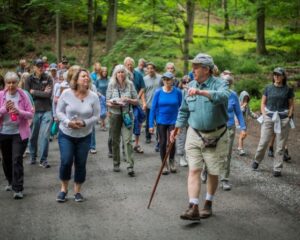Name of interviewee: Charles Hargens, Jr.
Date of birth/age at interview: August 30, 1893/91
Interviewer: Glenna Lang Bye, Ranulph Bye
Interview date: June 19, 1984
Interview location: Hargens studio in Carversville
Interview length: 55 minutes
Time span discussed: 1905 to 1984
Summary: This is an interview of an accomplished artist by two of his Solebury peers, the Byes. It contains descriptions of his childhood in the Blackhills of South Dakota that strongly influenced many of the themes and authenticity of his works. We also find a review of his school years at the Pennsylvania Academy of Fine Arts, his teachers, and the difficult work of selling his services to publishers. (Note: The sound is often difficult due to the age of the tape, and the last 10 minutes are of particularly poor quality. However we have left them on the tape for those interested in the dialogue about other artists he named and knew.)
Time markers:
00:29 – born in Hot Springs in Black Hills, SD; doctor and rancher father; influenced his art
02:50 – General Custer’s men crossed area many times; town of Deadwood, famous for Wild Bill Hickok
03:33 – mother painted, led him to artist’s life; could draw instinctively
05:10 – selling drawings at 6 years old for 25 cents, “beats punching cows”
06:15 – ranch on Cheyenne River, stone ford area where Sioux Indians crossed; became familiar with Indians; many reservation Indians patients of his father
08:51 – kept a small studio in Hot Springs, Indians were models
09:52 – photography, collected Western artifacts, devoted to the authentic
10:27 – his and his father’s Indian names: Charlie Push from pushing the shutter on camera and Big Smoke for his fiery character
11:34 – one brother, eventually managed ranch
11:58 – hay fever; family matters; step mother influenced him toward studying art
13:20 – early school and art lessons
14:23 – studied at from Pennsylvania Academy of Fine Arts, influenced by Wilmot Heitland
16:24 – review of student and class life: teachers included Hugh Breckenridge, Daniel Garber, Pearson, and Edmund Carter; visiting teachers Phillip Hale, George Harding, and others
18:09 – avid reader, source for composition of action scenes
18:50 – Academy life, composition classes; selling to Saturday Evening Post
21:38 – magazines in family house, impact on his imagination
23:55 – met future wife at the Academy, Marjorie also a successful illustrator of “style drawings”
25:35 – getting published as Illustrator; working as a sign illustrator
28:29 – his studio in Philadelphia; his wife’s studio on Washington Square; son at Episcopal Academy
29:51 – trips to New York City; Norman Rockwell; trying to sell illustrations
31:50 – later agent did selling; magazines had schedule, needed to trust you
32:59 – range of this employers: many book publishers and magazines; difficult getting started
35:13 – Western scenes became popular; his authenticity helped career take off
37:51 – specialization meant you would get work
38:47 – Mario Cooper, charcoal illustrator and watercolorist
39:52 – different media for illustrations; preferred pen and brush
42:10 – moved to Carversville in 1940; student weekend with Daniel Garber in Lumberville
43:20 – Marjorie commuted to Philadelphia by train until 1943, then stopped working
44:00 – friendly with George Sotter
(At this point the sound quality gets much poorer.)
49:22 – Solebury art world; Bill Ney, Harry Rosin
52:50 – met Edward Redfield once or twice


